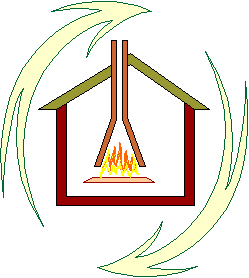Introduction
|
| People love fireplaces and stoves. Whenever potential home buyers are asked what features they would most like to have in their new home, a fireplace always figures prominently on their wish list. This is surprising, really, since fireplaces are so often a source of disappointment and annoyance to householders. The fireplaces in new homes disappoint by putting out less heat than expected; they annoy by spilling exhaust gases into the room when operating and spilling cold air and foul odors when they're not. Frustration with badly designed woodburning fireplaces could be one reason for the growing dominance of gas fireplaces in the hearth products market. Wood stoves installed using the same old and flawed ideas are just as frustrating. |
|
The other thing about fireplace and stove failure that breeds frustration is that everybody is an expert, but nobody seems to have the answers. Every bricklayer who has built a fireplace and every chimney sweep who has cleaned a hearth system have strong opinions as to what makes one successful. And strong views are not limited to the professionals; just about anyone who has ever built a fire is happy to share their pet theory of fireplace function. If opinions counted for anything, all natural hearths would work perfectly.
|
|
The housing research of the 1970s and 1980s yielded the principle of the house as a system which suggests that the house functions as a system rather than as a number of unrelated parts and that its various subsystems, particularly those that move or contain air, behave in an interactive way. What a concept! It has become a corner stone of residential building science and it provided the enthusiasm to support further research. The house as a system principle forces us to look a the consequences of the equipment, material and installation decisions made in the process of house design and construction. It means, for example, that we must acknowledge when the specifications for a new house call for a woodburning hearth and a downdraft kitchen range exhaust, that steps must be taken to ensure that these two devices will function in harmony. It also recognizes that wind, temperature and other environmental conditions influence the performance of the house and its components and so should be considered.
|
|
Laboratory and field research conducted in the 1980s on combustion venting, most notably by and for Canada Mortgage and Housing Corporation, began to shed light on how fireplaces and wood stoves interact with the house at a systems level. This research, combined with the insights of North America's most experienced and thoughtful hearth and housing specialists, produced a rich mixture of ideas that eventually gelled into the contents of this book. This is what the hearth business has lacked all this time: an integrated theory of appliance and chimney function supported by scientific fact.
|
|
Hearth products, the broad term that includes the appliances, venting systems and accessories that are combined to provide the visible fire in the home, are now available in bewildering variety. Aside from the fuel they burn, hearth appliances also vary in the way exhaust gases are vented to outdoors and these differences are the most significant for the behavior of the hearth in the house environment. To help in the analysis and discussion of the myriad types of hearth systems, here are five classifications based on venting strategy.
|
- Chimney Vented. This class includes woodburning fireplaces, wood stoves and furnaces, and is the primary emphasis in this book.
- Vertically Vented Gas. Included here are atmospheric gas and propane fireplaces, inserts and stoves with dilution device, usually a draft hood. Several of the principles covered in this book apply to this class.
- Forced Draft, Low Temperature Vent. Pellet stoves and fireplace inserts that may be vented vertically or horizontally (under favorable conditions) through pellet vent are in this class. A separate section of the book is devoted to pellet venting.
- Sealed Combustion. This includes direct vent gas and propane fireplaces and stoves with concentric exhaust and combustion air supply. It also includes fireplace inserts with non-concentric exhaust and air supply, both routed vertically through the original fireplace chimney. Direct vent appliances are, at least in theory, immune to many of the influences that cause chimney venting to fail. They are the right alternative for people who do not highly value the natural wood fire, but wish to incorporate a hearth in the home. Because the air supply and exhaust of these fireplaces flow independently of the house in which they are installed, this class of appliance is not covered in this book.
- Unvented. Unvented, or so-called vent-free, fireplaces and heaters are not discussed at all here. The reason is simple: their operational characteristics are incompatible with the house as a system principle. The idea of releasing the exhaust products from combustion equipment into the living space is a bad one. Unvented fireplaces pollute the indoor air; on that point there can be no argument, although their makers say it is not enough to be concerned about. Nevertheless, anyone even slightly concerned about the quality of their indoor air should avoid unvented gas appliances.
|
|
If it is to be a valuable addition to a home, a fireplace or stove should operate easily, make heat and never smoke or smell. The householder should never have to worry that it might act up. Fireplace perfection is possible and you will find the formula as you read on.
|
|
The purpose of this book is to support homeowners, builders, architects and hearth specialists who want to make sure that their fireplaces and stoves will function perfectly in the homes being built today.
|
